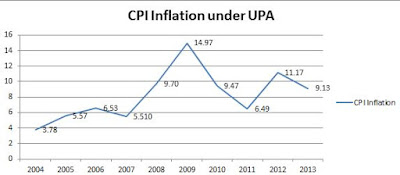Majority
of Indian Population is rural poor or urban middle class/poor, who continued to
struggle for two ends meal. As income sources are limited, most of Indian are
price sensitive thus wary of inflation. Consequently, political parties pay deep
attention to inflation phenomena and build their campaign around it. It is
note-worthy that Late Atal Ji had to resign due to high onion prices and BJP
build their political campaign around rising prices in 2014. In line with
global practices, India releases its consumer prices index (CPI) and whole sale
price index (WPI) but unfortunately, general public access inflation by
political propaganda rather than ground reality.
What is Inflation?
Consumer
Price Index (CPI) measure changes over time in general level of prices of goods
and services that households acquire for the purpose of consumption. In simple
terms, CPI inflation is increase of cost of living. For example: If cost of
living increase from INR 100 to INR 105, it will mean inflation of 5%. CPI inflation
is most broad based measured of inflation, which is based on spending habits of
Indian consumer.
Chart-1: Rural CPI Index
Above
chart depicts, weightage of various consumption goods and services of rural
India. As you will see, Food and Beverage has weightage of nearly 54% and
Miscellaneous has 27%, which includes health, transportation, education and
personal care. It is note-worthy that CPI index is based on actual spending
habit of an average consumer and tends to updated frequently. In simple terms, Rural CPI gives more importance of increase in Food prices than increase in cloth prices. Obviously, because food expense more critical than cloths.
Chart 2: India CPI Index
Above
chart depicts, weightage of various consumption goods and services of urban
India. As you will see, overall India spends nearly 46% food and beverages and
28% on miscellaneous products, which include Health, Transportation, education
and personal care. It is also note-worthy that fuel also represented nearly 7%. In simple terms, if common Indian spends INR 7 on fuel than she will spend nearly INR 46 on food, hence price rise of food is far more important than fuel price rise. This is does not mean that fuel prices hike does not have any impact but it means one should look at overall increase in cost of living to judge true impact of price rise.
Inflation under UPA:
Chart-3: Average Price Rise under UPA
Above
chart depicts UPA inherited lower inflation levels below 4%, but could not
retain inflation under control. It is note-worthy that UPA government lost
control after 2008 crisis and never able to get it back in control. UPA
government maintained lax fiscal policies and stand still decision making aggravated
supply side bottlenecks, which lead to further rounds of inflation. In simple terms, inflation in UPA II was well above 9%, which means cost of living was increased from 100 to 109 within a year.
Rather
than supporting RBI in lowering inflation – UPA government was in war of words
with RBI, pushing to reduce interest rates. Former, RBI Governor, Subbarao then
said –“ You cant bring it down without some sacrifices in growth, inflation is
a very regressive tax it hurts poor people more than relative better off
people. The voices hundereds of millions of poor people is not heard through
media.”
Inflation under Modi
Government:
Chart 4: CPI Inflation under Modi Government
India’s
CPI inflation eased sharply under Modi government and remained below tolerance
zone. As chart depicts, India’s CPI inflation was above 8.3%, when Modi
government took charge of office. Eversince, CPI inflation has tested low of
1.46% in June 2017 and remained well under control with last reading 3.77% in
September 2018. In simple terms, price rise has moderated under Modi government, which took various key measure reign inflation
expectations such as improvement on supply side bottlenecks, better management
of crops, controlled fiscal deficit and structured reforms.
Role of Central Bank
Global
central banks tend to have inflation targeting mandates, wherein they adjust
their monetary policy to contain inflation towards desired levels. For example-
In high inflation scenario central banks increase interest rates to make
borrowing costly and reduce easy money supply in economy. Higher borrowing cost
lead to lower demand, which in turn reduce inflation. Modi government have
legally mandated RBI to keep CPI inflation in a target range of 2-6%. As per
mandate – Monetary policy will be decided by 6 member committee, which will try
to keep inflation under check. This fiscal RBI has raised interest rates twice to battle rising fuel prices. RBI’s role is further underscored by active liquidity management to keep money supply to desired levels.
It
is note-worthy interest rate regime has little impact on food inflation, which
is largely depend on supply side bottlenecks. Former RBI governor, Raghuram
Rajan has lauded government’s effort in this regard. Recent upswing crude oil prices has surged the petrol prices, which in turn impact fuel inflation. PoliticSal parties has started to fuel the propoganda, citing INR 90 fuel prices. But a closer look overall increase in inflation paint vary different picture. In September 2018, CPI inflation was at 3.77%, which means the cost of living increase from INR 100 in September 2017 to 103.77 September 2018. Clearly, rising fuel prices are worrisome sign but they are yet impact common man.
At last, this blog just
want to put forward facts regarding price rise and explain reader that one
should not fall prey to political propaganda.
Reference:
Reference:
- https://www.numberbasket.com/india/economy/cpi/consumer-price-index-weights-table
- https://dbie.rbi.org.in/DBIE/dbie.rbi?site=home
- https://www.inflation.eu/inflation-rates/india/historic-inflation/cpi-inflation-india.aspx
- https://economictimes.indiatimes.com/news/economy/policy/duvvuri-subbarao-responds-to-p-chidambaram-says-inflation-hurts-poor/articleshow/21541055.cms




No comments:
Post a Comment